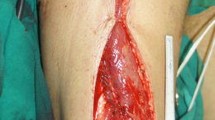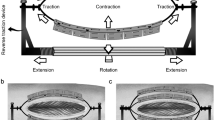Abstract
Closure of large soft-tissue defects following surgery or trauma constitutes substantial but common reconstructive challenges. Closing the wounds with sutures is a common solution yet involving high-tension closure. The alternative methods of closure such as skin grafting are often associated with relatively more complex surgical procedures, significant morbidity, and extended hospitalization and recovery periods. Here, we evaluate the efficacy of a tension relief system (TRS) device and compare it to surgical sutures. We employed finite element modeling and simulated three cases of (real) large wounds which were treated with TRS in reality, each located in a different organ and has different dimensions. Closure of the wounds induced peak-effective stresses on the skin that were at least an order of magnitude greater (and sometimes nearly 2 orders of magnitude greater) than when tension sutures were used with respect to the corresponding TRS data. For the tension suture simulations, the tensile stress was in the range of 415–648MPa and in the TRS simulations, it was 16–30MPa. Such large localized tissue distortions may obstruct the vasculature surrounding the wound or at the sutured skin itself, which will cause ischemia and necrosis of the skin within several hours following surgery. In addition, the substantial reduction of loads on and within the skin during large wound closure by the TRS allows surgeons to optimally employ the viscoelastic properties of the skin for primary wound closure.
Access provided by CONRICYT-eBooks. Download conference paper PDF
Similar content being viewed by others
Introduction
Closure of large soft tissue defects following surgery or trauma constitutes substantial but common reconstructive challenges (Topaz et al. 2014). Closing wounds with sutures has been the gold standard approach since the early days of surgery, yet it may be impeded and limited, particularly with regard to large wounds (Al-Mubarak and Al-Haddab 2013). In such cases, an attempt to use conventional suturing will result in high-tension closure, and therefore, alternative external skin stretching systems (TRS) were developed. These types of devices were meant to reduce local mechanical loads in skin and underlying tissues, and allow taking advantage of the viscoelastic properties of the skin (Topaz et al. 2012).
Studies have shown the clinical advantages of skin stretching systems, however, quantitative bioengineering models, demonstrating closure of large wounds, are lacking.
Here, we present a finite element (FE) modeling of the TRS and its biomechanical efficacy in three (real) wound cases, compared with the alternative of a conventional surgical suturing closure technique, which has not been used in these reported cases.
Methods
To make the modeling and simulations more realistic and clinically relevant, we modeled the TopClosure® TRS in its application as an external tissue stretching system in three specific large wounds. The TopClosure® comprises of two polymer attachment plates (APs) that are fixed to the skin and are pulled together manually by an interconnecting flexible approximation strap (AS) (Fig. 1a). Each of the three wounds, in reality, was located in a different body region, in three different patients. The geometrical models of the tissue defects were built per each wound case using the Scan-IP module of Simpleware® and then the APs of the TRS were added according to the number of APs that were used in practice, to close the real specific wound. For the analyses of wound closure using tension sutures, 0.6 mm-thick half-rings were simulated, matching the diameter of the tension sutures that would have been used in these cases, in both sides of the wound (Fig. 1b). For the purpose of a sensitivity analysis, we created three additional wound model configurations, each containing additional sutures. These last three models were built in order to measure the effects of an optional solution in each of these wound situations, which is to close the wounds with more sutures. Both the APs and the tension sutures were displaced in the horizontal direction toward closing the wound (Fig. 1).
The configurations of the finite element models, with boundary and loading conditions: a Wound closure using the TopClosure® tension relief system (IVT Medical Inc., Ra’anana, Israel). The layered structure of the tissues represented in the model is depicted in the top right panel. b Wound closure using tension
The wound closure models were analyzed for Lagrange stresses. Outcome measures included: (1) Distributions of effective stresses in the tissue VOI. (2) Peak effective stresses in the tissues. (3) Tensile stress in the tissues. These outcome measures were compared between the TRS closure option (which was taken in reality) and the suture closure option in each wound case.
Results
Closure of all the wounds by both the TRS system and tension sutures induced localized stresses in the skin and deeper tissues. These stresses reached maximum values around the APs for the TRS closures as well as around the insertion sites of the sutures, mostly in the side opposite to the wound due to the pulling activity of the two closure techniques (Fig. 2). Closure of the wounds induced peak effective stresses on the skin that were at least an order of magnitude greater (and sometimes nearly 2 orders of magnitude greater) when tension sutures was used with respect to the corresponding TRS data. For the tension suture simulations, the tensile stress was in the range of 415–648 MPa and in the TRS simulations, it was 16–30 MPa.
Discussion and Conclusions
Computational FE modeling is extremely useful for comparing biomechanical efficacies of medical devices and surgical techniques in the wound prevention and treatment arena, particularly regarding the distributions of mechanical loads in tissues, which cannot be measured directly (Halloran et al. 2005; Levy et al. 2014, 2015). From Fig. 2, Query it is clear that the local skin stresses are much greater in magnitude and focally concentrated around the insertion sites of the tension sutures with respect to the tissues adjacent to the APs of the TRS. The APs distribute the deformations more uniformly, and hence, magnitudes of tissue stresses around them are 1–2 orders of magnitude lower (Fig. 2). Such large and sustained localized tissue deformations caused by tension sutures may critically distort cells and obstruct the vasculature surrounding the wound, which may cause necrosis of the skin within several hours post-operation. In addition, the substantial load reduction by the TRS during large wound closure allows surgeons to optimally employ the viscoelastic properties and biological adaptation of the skin.
References
Al-Mubarak L, Al-Haddab M (2013) Cutaneous wound closure materials: an overview and update. J Cutan Aesthet Surg 6(4):178–188
Halloran JP, Petrella AJ, Rullkoetter PJ (2005) Explicit finite element modeling of total knee replacement mechanics. J Biomech 38(2):323–331
Levy A, Kopplin K, Gefen A (2014) Computer simulations of efficacy of air-cell-based cushions in protecting against reoccurrence of pressure ulcers. J Rehabil Res Dev 51(8):1297–1319
Levy A, Frank MB, Gefen A (2015) The biomechanical efficacy of dressings in preventing heel ulcers. J Tissue Viability 24(1):1–11
Topaz M, Carmel NN, Silberman A, Li MS, Li YZ (2012) The TopClosure 3S system, for skin stretching and a secure wound closure. Eur J Plast Surg 35:533–543
Topaz M, Carmel NN, Topaz G, Zilinsky I (2014) A substitute for skin grafts, flaps, or internal tissue expanders in scalp defects following tumor ablative surgery. J Drugs Dermatol 13:48–55
Author information
Authors and Affiliations
Corresponding author
Editor information
Editors and Affiliations
Rights and permissions
Copyright information
© 2018 Springer International Publishing AG
About this paper
Cite this paper
Katzengold, R., Topaz, M., Gefen, A. (2018). Tissue Loads Applied by a Novel Medical Device for Closing Large Wounds. In: Gefen, A., Weihs, D. (eds) Computer Methods in Biomechanics and Biomedical Engineering. Lecture Notes in Bioengineering. Springer, Cham. https://doi.org/10.1007/978-3-319-59764-5_27
Download citation
DOI: https://doi.org/10.1007/978-3-319-59764-5_27
Published:
Publisher Name: Springer, Cham
Print ISBN: 978-3-319-59763-8
Online ISBN: 978-3-319-59764-5
eBook Packages: EngineeringEngineering (R0)






